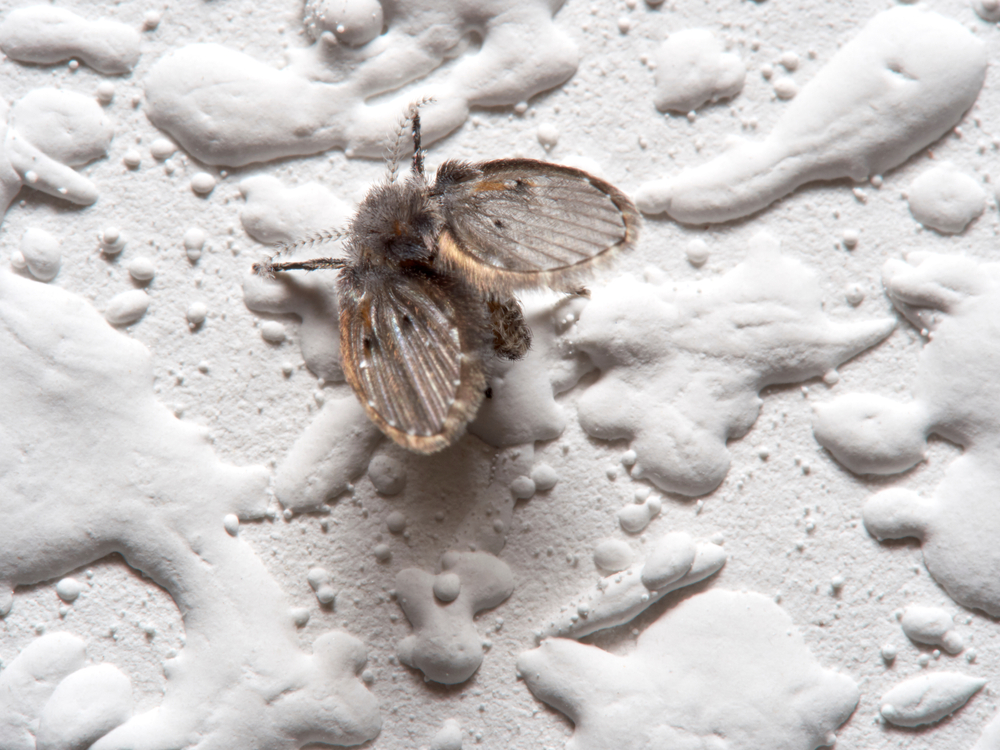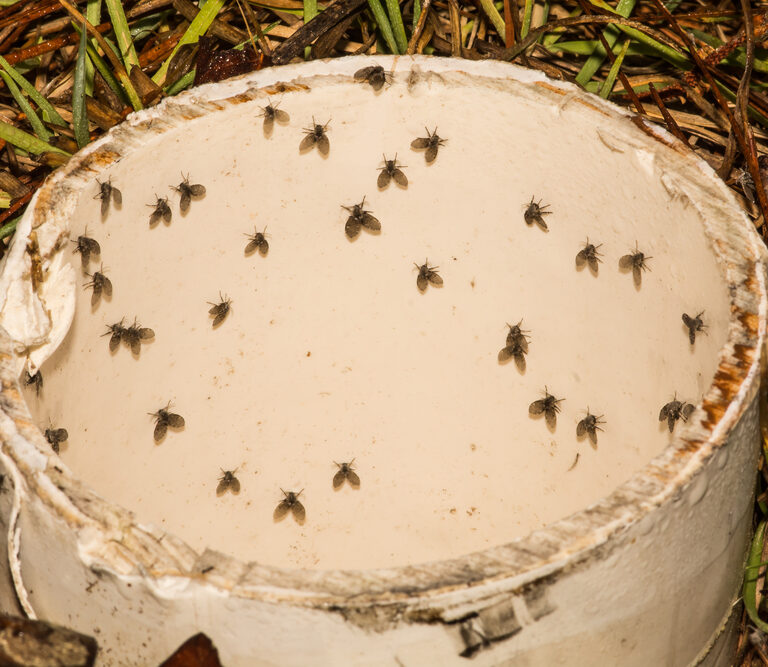Flies are a common household pest. But houseflies aren’t the only type of fly that can reside in your home. Drain flies are a different type of fly that, as you probably guessed, live in your drains.
Like most flies, these guys can be quite a nuisance, and they may indicate a problem with your plumbing. Nevertheless, getting rid of drain flies is quite quick and simple.
Drain Fly FAQs
If you have a drain fly problem, you’re probably wondering what they are and where they come from. For your convenience, we’ve briefly outlined some information about them that should answer your questions.
What Are Drain Flies?
Drain flies are species of flies from the Psychodidae family. They may also go by other nicknames, such as moth flies, sink flies, and sewer gnats, due to their unique appearance and proclivity to mingle in and near sink drains and sewers.
Where Do Drain Flies Come From?
Drain flies are naturally found in wet areas with stagnant water, such as in woods and wetlands. However, since they reproduce near organically-rich stagnant water, they’re commonly found outside in areas such as gutters, plant pots, storm drains, and bird feeders.
As with any other type of fly, they make their way into your home through open airways. They can also make their way in through your plumbing, and may occupy household drains – particularly bathroom and kitchen sink drains.
Are Drain Flies Harmful?
The drain flies most commonly found in bathrooms and kitchens, Clogmia albipunctata, are considered to be relatively harmless. They do not bite, and are not known to carry human-transmissible diseases.
However, there are reports of myiasis – a parasitic infestation of fly larvae in the skin – caused by Clogmia albipunctata larvae. Also, since they inhabit sewage pipes, they are prone to carrying some pretty nasty bacteria.
How Can You Tell if You Have Drain Flies?
If you believe you have drain flies in your home, there are a couple of simple methods for checking for an infestation. Simply place a piece of tape, large enough to cover the entire drain, over the drain and leave it overnight. If there are drain flies in your drain, they’ll eventually emerge from the drain and get stuck to the tape while trying to leave.
Alternatively, you can generously line a bowl with petroleum jelly and place it over the drain overnight in an upside down position. This will have the same effect as the tape, trapping the flies in the thick goop.
Not only are these great ways to tell if you have a drain fly infestation, but they’re also good ways to gauge how bad the infestation might be.

Getting Rid of Drain Flies
Once you’ve identified a possible infestation, you’ll want to get rid of it before it becomes a serious issue. Fortunately, getting rid of drain flies is rather quick and easy.
Hot Water
A simple and effective way to wash drain flies away is by using really hot water. This will kill any flies in the pipe, as well as any eggs and larvae.
For this method, you’ll want to heat up some water on the stove. However, you’ll want to avoid using boiling water if you’ve got PVC pipes, as the heat can soften or melt the pipes, leading to much bigger problems.
Baking Soda + Vinegar + Salt
If hot water doesn’t do the trick, the combination of baking soda, vinegar, and salt should.
Thanks to the reaction that occurs when baking soda and vinegar mix, this foaming solution should help reach flies in your pipes that escaped the hot water bath. The salt is added for an additional abrasive to help dislodge and kill stragglers.
When using this solution, you’ll want to let it sit overnight, and flush with hot water the next morning.
DIY Fly Traps
Drain flies can actually be beneficial for your pipes, as they feast on the raw sewage buildup. If you want to leave the eggs and larvae, but want to control the adult population, a simple DIY fly trap can help hamper the population.
Water + Sugar + Soap + Vinegar
You’ll want to add a few drops of liquid soap to a container filled with water, apple cider vinegar, and sugar. The sweet and sour mixture will draw the flies in, and the soap will add enough viscosity to the solution to keep them trapped there.
Apple Cider Vinegar + Plastic Wrap
Another simple and effective fly trap involves filling a bowl or cup with apple cider vinegar and covering it with plastic wrap. Punch a few small holes in the plastic wrap with a toothpick and set it where near the drain. The flies, attracted to the vinegar, can easily enter the trap for a quick treat but won’t be able to escape.
Tape or Petroleum Jelly + Bowl
Remember how we mentioned you can use tape or a petroleum jelly-coated bowl to check for a drain fly infestation? Well, these are also effective ways to tame the problem as well.
Simply stick the tape or bowl over the drain and leave it for a few days. This will prevent the flies from coming out of the drain, and can trap them to hinder their ability to further procreate.
Drain Cleaners
Other solutions work to address the symptoms of the problem, but fail to address the cause. Drain cleaners are a great way of controlling a drain fly infestation by cleaning the gunk the flies feed on from the walls of the pipe. This will hinder their ability to thrive in your pipes, making them a better long-term solution than hot water and traps.
While technically any drain cleaner can work, you’ll need a drain cleaner that can reach the entirety of your pipes. Both foaming and gel drain cleaners can work well to dissolve buildup on every area of your pipes.
However, chemical drain cleaners are harsh and can harm you if improperly handled. They also aren’t typically suitable for septic tanks. If you’re looking for a gentler, yet effective drain cleaner, you might opt for an enzymatic drain cleaner. These use microorganisms to slowly eat away at buildup in your drain, and won’t harm you or your septic system.
WARNING!
If you’ve recently used vinegar or any other chemical in your pipes (natural or otherwise), thoroughly flush them with water before using a harsh chemical drain cleaner.
These drain cleaners typically contain chemicals such as bleach (sodium hypochlorite) and lye (sodium hydroxide), which may interact with chemicals like vinegar to create toxic gas, putting you and your family at serious risk.
How to Keep Drain Flies at Bay
Drain flies are easy enough to get rid of. But if you want to keep them from coming back, you’ll need to address the source of the issue. That source is usually a clog or other buildup in your pipes.
Flushing your pipes regularly with hot water can hamper your drain fly problem by washing the flies away. Likewise, a proper drain cleaner to clean the buildup in your pipes can help create an inhospitable environment for flies. Whether you flush your pipes or use a drain cleaner, you’ll want to perform routine maintenance in order to keep the flies at bay.
Also, you’ll want to ensure there’s no standing water anywhere in your home. That means you should empty any containers with standing water, such as mop buckets. Leaks can also be a source of standing water, so you should address them to avoid water from pooling in inconspicuous areas where the flies may reproduce.
Finally, if you see any drain flies, take care to eradicate any possible infestation as soon as possible. Nipping the problem in the bud can prevent bigger problems in the future.
Wash Your Worries Away
Like all flies, drain flies are pesky and annoying. Luckily, they’re easy to get rid of. If you’ve got drain flies hanging buzzing around in your home, a simple homemade fly trap and a bit of drain maintenance should take care of the problem quickly and easily.
